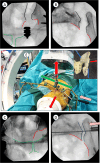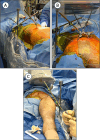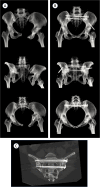Percutaneous pelvic ring fracture reduction using an external fixator: a technical trick and case series
- PMID: 40172657
- PMCID: PMC12178971
- DOI: 10.1007/s00264-025-06509-0
Percutaneous pelvic ring fracture reduction using an external fixator: a technical trick and case series
Abstract
Purpose: Pelvic ring and acetabular fractures pose significant morbidity and mortality risks due to substantial haemorrhage and internal organ injury. Many percutaneous reduction techniques involve manipulating the injured side while stabilizing the uninjured side, often requiring specific or costly equipment. This article presents a technique for creating a pelvic reduction frame using a standard external fixator.
Method: We included surgical pelvic ring fractures between 2018 and 2022. Pelvic reduction was achieved using an external fixator (Hoffmann III, Stryker Corporation, Kalamazoo, Michigan, USA). Reduction quality was assessed according to the technique described by Lefaivre et al., based on the following criteria: mean asymmetry (mm), mean deformity index (mm), and mean maximum horizontal or vertical displacement (mm).
Results: 15 patients (10 men, 5 women, mean age 35 years) underwent surgical treatment for pelvic fractures using an external fixator and percutaneous fixation. Mean operative time was 130 min (range, 80-276). Postoperative imaging showed a mean maximum displacement of 5.4 mm and a mean asymmetry of 3.7 mm, with excellent or good reductions in 11 cases.
Conclusion: This system uses widely available equipment and enables the benefits of percutaneous techniques, but surgical expertise remains the key to success.
Keywords: External fixator; Minimally invasive technique; Pelvic trauma; Percutaneous pelvic ring fracture reduction; Reduction technique.
© 2025. The Author(s).
Conflict of interest statement
Declarations. Human ethics and consent to participate: Not applicable. Competing interests: The authors declare no competing interests.
Figures




Similar articles
-
Anterior minimal invasive internal fixator versus open plating in treatment of unstable pelvic ring injuries.Arch Orthop Trauma Surg. 2025 May 9;145(1):282. doi: 10.1007/s00402-025-05891-z. Arch Orthop Trauma Surg. 2025. PMID: 40343528 Free PMC article.
-
Interventions for treating supracondylar elbow fractures in children.Cochrane Database Syst Rev. 2022 Jun 9;6(6):CD013609. doi: 10.1002/14651858.CD013609.pub2. Cochrane Database Syst Rev. 2022. PMID: 35678077 Free PMC article.
-
Pin Site-Related Outcomes After Temporary Staging External Fixator Pin Placement Using the Self-Drilling Pin Insertion Technique.J Orthop Trauma. 2025 Jun 1;39(6):283-287. doi: 10.1097/BOT.0000000000002977. J Orthop Trauma. 2025. PMID: 40085920
-
Minimally invasive stabilization of the anterior pelvic ring in fragility fractures using a submuscularly implanted internal fixator - a retrospective case series of 34 geriatric patients.Eur J Trauma Emerg Surg. 2025 Jun 16;51(1):228. doi: 10.1007/s00068-025-02893-9. Eur J Trauma Emerg Surg. 2025. PMID: 40522490 Free PMC article.
-
The relation between surgical approaches for pelvic ring and acetabular fractures and postoperative complications: a systematic review.Eur J Trauma Emerg Surg. 2023 Apr;49(2):709-722. doi: 10.1007/s00068-022-02118-3. Epub 2022 Nov 25. Eur J Trauma Emerg Surg. 2023. PMID: 36434301 Free PMC article.
References
-
- Gylling SF, Ward RE, Holcroft JW et al (1985) Immediate external fixation of unstable pelvic fractures. Am J Surg 150:721–724. 10.1016/0002-9610(85)90416-7 - PubMed
-
- Evers BM, Cryer HM, Miller FB (1989) Pelvic fracture hemorrhage. Priorities in management. Arch Surg 124:422–424. 10.1001/archsurg.1989.01410040032006 - PubMed
-
- Apivatthakakul T, Maher M, Tetreault A et al (2019) We only see what we know: Structures at risk during the anterior intrapelvic approach. Injury 50:1407–1410. 10.1016/j.injury.2019.07.031 - PubMed
-
- Banaszek D, Starr AJ, Lefaivre KA (2019) Technical considerations and fluoroscopy in percutaneous fixation of the pelvis and acetabulum. J Am Acad Orthop Surg 27:899–908. 10.5435/JAAOS-D-18-00102 - PubMed
-
- Starr AJ, Walter JC, Harris RW et al (2002) Percutaneous screw fixation of fractures of the iliac wing and fracture-dislocations of the sacro-iliac joint (OTA Types 61–B22 and 61–B23, or Young-Burgess “Lateral Compression Type II” Pelvic Fractures). J Orthopaedic Trauma 16:116–123. 10.1097/00005131-200202000-00008 - PubMed
MeSH terms
LinkOut - more resources
Full Text Sources
Medical

